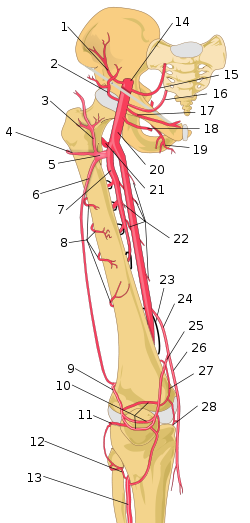Arteries of the lower limbs
The main arteries of the lower limb include the femoral artery, popliteal artery, aa. tibiales and then the smaller arteries of the foot such as the a. plantaris medialis et lateralis and a. dorsalis pedis.
Arteria femoralis[edit | edit source]
The a. femoralis is a continuation of the a. iliaca externa from the lig. inguinale. The a. femoralis passes through the lacunum vasorum, where it is centrally located next to the nervus femoralis, which lies most laterally and runs through the lacunum musculorum. The a. femoralis then runs into the popliteal fossa through the hiatus adductorius. V. femoralis, on the other hand, is located more medially and gradually passes behind the artery until it reaches the outer side.
According to the course, the a. femoralis has three sections:
- Part in the trigonum femorale and fossa iliopectinea
- The section below the m. sartorius
- The last section from the canalis adductorius to the hiatus tendineus
A sensory branch from the n. femoralis, the n. saphenus, accompany the artery to the last two sections.
Supply area[edit | edit source]
The A. femoralis and its branches supply the skin on the anterior lower abdomen, the anterior scrotal or pubic region, and all formations of the thigh, including the knee joint.
Branches[edit | edit source]
Arteria epigastrica superficialis[edit | edit source]
A thin branch that ascends and branches into the subcutaneous tissue towards the umbilicus.
Arteria circumflexa ilium superficialis[edit | edit source]
Passes through the subcutaneous tissue of the thigh along the lig. inguinale to the spina iliaca anterior superior.
Arteriae pudendale externale[edit | edit source]
Two branches, one curving into the pubic region and the other radiating:
- rr. scrotales/labiales anteriores to the external genitalia.
Arteria profunda femoris[edit | edit source]
A very strong main artery for the thigh muscles, which branches off laterodorsally about 3-5 cm below the lig. inguinale - but the spacing can be quite variable. It gives off:
- a. circumflexa femoris medialis - passes to the fossa iliopectinea, posteriorly to the hip joint and for the pelvitrochanteric muscles, posterior thigh muscles and adductors.
- a. circumflexa femoris lateralis - continues under the m. rectus femoris and supplies all components of the m. quadriceps femoris
- r. descendens - a branch of the artery descending to the knee joint.
- aa. perforantes - the terminal branch that passes dorsally through the slits between the adductor processes. They supply the adductors and all the muscles of the dorsal group, at the same time the aa. nutriciae femoris emerge from them.
Arteria genus descendens[edit | edit source]
It leaves at the canalis adductorius, then joins the vena and n. saphenus, and together they pass through the vastoadductor membrane. Its area of supply is the muscles of the thigh, and it joins the vascular network of the knee joint-the rete articulare genus. In addition to the main branches, there are minor branches for the inguinal lymph nodes and muscular branches.
Arteria poplitea[edit | edit source]
A. poplitea is a continuation of the a. femoralis artery after it passes through the adductor hiatus into the popliteal fossa. It ends with the distal end of the m. popliteus. In the fossa poplitea the a. poplitea lies most profoundly, the v. poplitea then lies more dorsolaterally, and the n. tibialis is most superficial.
A. poplitea sends out smaller branches: a. superior medialis genus, a. superior lateralis genus, aa.surales, a. inferior medialis genus and a. inferior lateralis genus. This artery is terminated by a. tibialis anterior and a. tibialis posterior.
Arteria tibialis anterior[edit | edit source]
A. tibialis anterior comes forward between the tibia and fibula through the extensors on the tibia. It passes through the retinaculum musculorum extensorum inferius, and after its passage it becomes the a. dorsalis pedis. Along with it pass two vv. tibiales anteriores and n. peroneus communis. The a. tibialis anterior supplies the knee joint, the formations on the anterior side of the tibia, the dorsum of the foot and the toes, and by its connections it contributes to the supply of the plantar region.
The branches of a. tibialis anterior are: a. recurrens tibialis posterior, a. recurrens tibialis anterior, a. malleolaris anterior medialis, a. malleolaris anterior lateralis.
The branches of the a. dorasalis pedis are: a. tarsalis lateralis, aa. tarsales mediales, and a. arcuata, which sends out aa. metatarsales dorsales (of which the ramus plantaris profundus, which anastomoses with the arcus plantaris profundus).
Arteria tibialis posterior[edit | edit source]
A. tibialis posterior runs under the arcus tendineus musculi solei, along the posterior aspect of the tibia, and continues behind the medial malleolus, where it can be palpated. The canalis malleolaris passes over the plantus and the retinaculum musculorum flexorum covers it. Along with it go two vv. tibiales posteriores and n. tibialis.
The branches of the a. tibialis posterior on the tibia are: r. circumflexus fibulae, rr. malleolares mediales, rr. calcaneares, and a. fibularis, which passes through the Hyrtle canal to behind the lateral malleolus.
The branches of a. tibialis posterior for the plantus are: a. plantaris medialis and a. plantaris lateralis, which gives off the arcus plantaris profundus. The arcus plantaris profundus anastomoses with the ramus plantaris profundus of the arteriae metatarsalis dorsalis and gives off the aa. metatarsales plantares, which continue to the toes as the aa. digitales plantares communes.
Links[edit | edit source]
Related articles[edit | edit source]
References[edit | edit source]
- ČIHÁK, Radomír. Anantomie 3. 1997. edition. 2004. pp. 123–127. ISBN 80-247-1132-X .

